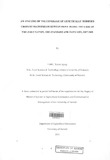| dc.description.abstract | The period between June 2007 and February 2009 saw Kenya's national biosafety legislation, the Biosafety Bill, go through the parliamentary process culminating in its being passed into law. During this period, and the six months after the Bill's enactment into law, the public debate on biosafety almost became synonymous with that of genetically modified organisms (GMOs), especially as applied to staple crops. This debate was catalyzed by the print media through news articles, editorials and expert opinion articles. These articles could have impacted the general public either negatively or positively leading to development of similar opinions.
This study was therefore designed to carry out a content analysis of the mainstream Kenyan print media coverage of genetically modified crops during that period, with a view to assess the manner in which the coverage may have impacted the public. Drawing on the agenda-setting and framing theories, a comprehensive analysis was carried out on a total of95 articles together published in the Daily Nation, The Standard and Taifa Leo during the period. This was to assess the frequency, type, tone, length, authorship and scientific accuracy of the articles as well as the main stakeholders quoted and the frames used to represent GMOs in the articles.
Results showed that the coverage of GMOs by the Kiswahili-Ianguage newspaper, Taifa Leo, was generally low compared to the coverage by the English-language newspapers, Daily Nation and The Standard. Overall, the coverage by all newspapers lacked depth, objectivity and analytical competence. The articles were short to medium in length with letters to the editor forming the majority of the published articles. Majority of the articles showed biases either for or against GMOs and only about 10% contained accurate basic information about GMOs or GM technology. Most (65%) of the articles were written by non-specialist authors (general journalists and editors) with science journalists and specialists in agricultural biotechnology responsible for authoring a relatively lower proportion (16%) of the articles.
Research scientists and government officials, who in general tended to speak in favour of GMOs, were the most widely quoted sources. The voices of farmers and consumer groups were rarely covered. The dominant frames, agriculture and safety, represented GMOs from the perspective of potential benefits accruing from improved farm productivity and potential risks to human health, respectively, but the actual benefits or risks associated with GMOs or GM technology were not quantified. The study established that the media coverage of GMOs by the three dailies was poor, and that there is need for general improvement on this coverage.
Their improvement will enable the general public benefit from well- researched, balanced and analytical reporting of GMOs to fully participate in discussions and debate about GMOs and, consequently, make informed decisions on whether or not to adopt GMOs in their crop production systems. By extension, there is also a general need to improve the print media coverage of scientific research, technology and innovation topics, particularly those that are likely to raise controversy among the public, so as to enhance the level of public awareness and understanding of these topics. | en_US |

